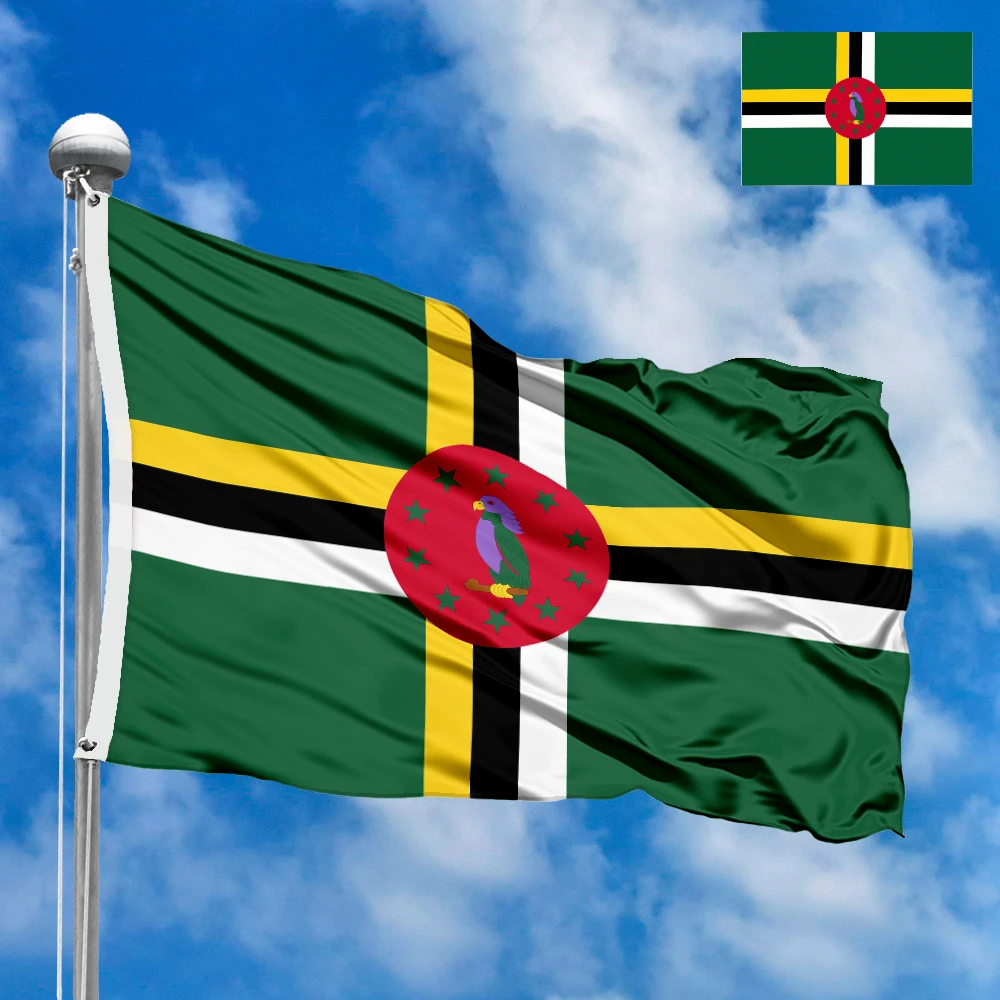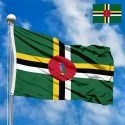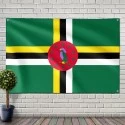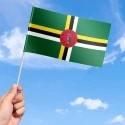The national flag of Dominica is a vibrant and distinct symbol, celebrated for its complex design and rich symbolism. It stands out among Caribbean flags, not only for its use of multiple colors but also for its central emblem: the Sisserou parrot, a species endemic to the island. Adopted in 1978 upon gaining independence, the flag represents the nation’s natural beauty, its people’s unity, and its commitment to a prosperous future. It is a source of immense national pride and a powerful visual representation of the "Nature Isle of the Caribbean."
A Detailed Look at the Flag's Design and Symbolism
The flag of Dominica features a green field, which is divided into four equal quadrants by a tricolor cross. The cross consists of three stripes: a vertical and horizontal stripe of yellow, black, and white. At the very center of the flag is a red disk, which contains a circle of ten yellow stars, and in the middle of the stars, the national bird—the Sisserou parrot—is depicted, perched on a branch.
Each color and element on the flag is deeply symbolic, reflecting the core principles of the Dominican nation:
-
Green: The green field represents the lush, forested landscape of Dominica, a nation celebrated for its pristine natural beauty and vibrant flora. It symbolizes the country's rich agricultural heritage and its commitment to environmental stewardship.
-
The Cross (Yellow, Black, and White): The tricolor cross represents the Holy Trinity and the nation’s faith. It also symbolizes the nation’s diverse population and its commitment to unity.
-
Yellow: The yellow stripes symbolize the sunshine of the Caribbean and the nation’s primary agricultural products, particularly citrus and bananas. It also represents the warmth and hospitality of the Dominican people.
-
Black: The black stripes symbolize the rich volcanic soil of Dominica, as well as the heritage of its people. It is a tribute to the African heritage of the majority of the population and their resilience.
-
White: The white stripes represent the clarity of the nation’s rivers and waterfalls, as well as its dedication to peace and purity of purpose.
-
The Red Disk: The central red disk symbolizes social justice and the nation’s commitment to a just and equitable society. It is a symbol of the nation's passion and the blood shed in the pursuit of independence.
-
The Ten Stars: The ten yellow stars circling the Sisserou parrot represent the ten parishes of Dominica, shining brightly in the firmament of the nation. They symbolize hope and the equal status of all the island's parishes.
-
The Sisserou Parrot: The Sisserou parrot, also known as the Imperial parrot, is Dominica's national bird and is found only on this island. It is a powerful symbol of the nation's unique identity, its aspirations for a bright future, and its rich biodiversity. The parrot is often a symbol of flight toward a brighter future and the country's unique place in the world.
Dimensions and Proportions
The official flag of Dominica has a width-to-length ratio of 1:2. The vertical and horizontal stripes of the cross are of equal width, ensuring a balanced and harmonious design. The central red disk is perfectly centered on the flag. The design has undergone slight modifications over the years, but its core elements have remained consistent, preserving the original vision of the flag's creators.
The Genesis and Adoption of the Flag
The current flag of Dominica was adopted on November 3, 1978, the day the nation gained full independence from the United Kingdom. It was designed by playwright and painter Alwin Bully, who created a unique emblem that celebrated both the nation’s natural beauty and its political independence. The design was the result of a national competition and was chosen for its comprehensive symbolism and aesthetic appeal. The flag was a definitive statement of Dominica's new status as a sovereign and independent nation.
Meaning and Significance for Citizens
For the people of Dominica, the flag is a cherished emblem of their nation's unique identity. It is a symbol of their unity, diversity, and the "Pura Vida" (Pure Life) philosophy of the island. The flag is proudly displayed on government buildings, schools, and homes, especially during national holidays like Independence Day on November 3rd and National Day of Service on November 4th.
The flag’s imagery, with its reference to the island’s endemic parrot, its volcanic soil, and its lush forests, resonates deeply with the population, reinforcing their connection to their homeland. It is a powerful reminder of the values that unite them—their love for nature, their faith, and their commitment to a peaceful and just society. For Dominicans living abroad, the flag is a tangible link to their roots and a source of deep-seated pride.
Interesting Facts
-
The flag of Dominica has been slightly modified three times since its adoption, but the Sisserou parrot has remained the central emblem.
-
The Sisserou parrot is one of the rarest parrots in the world and is found only in the forests of Dominica, making its inclusion on the flag a powerful statement of national identity.
-
The ten stars on the flag represent the ten parishes of Dominica: St. Andrew, St. David, St. George, St. John, St. Joseph, St. Luke, St. Mark, St. Patrick, St. Paul, and St. Peter.
-
The flag is also a symbol of Christian heritage, with the cross representing the Holy Trinity and the red color of the disk representing the body of Christ.
-
The flag's design is unique among national flags, with a complex combination of colors and symbols that tell a comprehensive story of the nation's history and values.
В целом, флаг Доминики является шедевром символического дизайна. Его цвета и сложный герб рассказывают всестороннюю и трогательную историю о природной красоте, богатой истории и незыблемых ценностях нации. Это мощная эмблема национальной идентичности, напоминание о её уникальном месте в мире и источник глубокой гордости для всех доминиканцев.
In the demonstration images, full-size flags are shown with proportions of 2:3, and hand-held flags with proportions of 1:2.






 Waving flag
Waving flag
 Sizes:
Sizes:
 Round flag
Round flag
 Sizes:
Sizes:
 Rectangular flag 2:3
Rectangular flag 2:3
 Sizes:
Sizes: